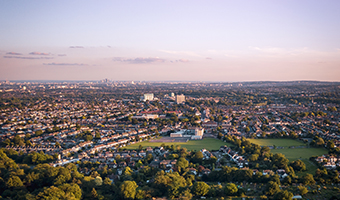New legislation came into force from 1 August 2020 allowing purpose-built blocks of flats and dwellinghouses to be extended upwards by up to two additional storeys.
Build, Build, Build
The new legislation includes a whole raft of changes and additional Permitted Development rights alongside a significant investment in infrastructure, demonstrating the Prime Minister’s commitment to rebuilding the UK’s post-COVID-19 economy.
In the case of purpose-built, detached blocks of flats, the construction of the new dwellinghouses must be immediately above the existing topmost residential storey and should not exceed two additional storeys.
The same rules apply to existing dwellinghouses consisting of two or more storeys although single-storey dwellinghouses may only be extended upwards by one additional storey.
The upward extension rights are of particular interest to us as we have been working with clients in this sector, some of whom have long advocated for an airspace Permitted Development right.
Sense of scale
Apex Airspace, who is at the forefront of this sector, undertook research in 2016 with HTA Design LLP. Based upon a detailed case study assessing the airspace potential across the London Borough of Camden, the research suggested there could be circa 14,330,080 m2 of developable roof space capable of delivering up to 179,125 new homes in Greater London (42% of the London Plan 2015 housing target). While the research was undertaken four years ago, upward extension development has not taken place at pace, so we expect that these numbers would be broadly the same now.
Our overall response (as well as most of our clients) is that these new rights are welcome, as they will open up new opportunities to deliver new homes at an increased pace and volume.
Inflexible system
Our experience working in this field thus far has found the current Planning system has prevented a considerable amount of airspace development coming to fruition, due to the uncertainties around policy interpretation. In particular, there have typically been issues concerning the acceptability of achieving new height and massing. The new rights remove the grey areas in relation to building height and now provide certainty for any buildings that are eligible to utilise the rights.
While there will be question marks around what the legislation allows Local Planning Authorities to potentially refuse prior approval applications based upon the proposed external appearance of extended buildings, we recognise that forward thinking London Boroughs are already in the process of preparing and adopting Supplementary Planning Documents (SPDs) focused on airspace design guidance.
In these instances, where there is specific airspace extension guidance in place, this should provide clarity around what is acceptable design.
Growth opportunity
We anticipate that the new legislation will open the sector up to new entrants, many of whom have up until now been dissuaded by the delays, risks and issues associated with the public consultation process and the possibility of decisions being made at Planning Committee.
That said, there will be serious concerns from the public sector around how the prior approval determination process can realistically be resourced if applications are charged at the same pittance rates as the other current prior approval applications. We believe that for this to be a success, Local Planning Authorities need to be able to charge appropriate fees for their work processing and assessing the applications.
What the rights will permit
Blocks of flats and dwellinghouses will only benefit from these rights if they were constructed between 1st July 1948 and 5th March 2018, and must be three storeys or more above ground level.
The rights will allow for:
- Engineering operations reasonably necessary to construct the additional storeys and new dwellinghouses;
- Works for the replacement of existing plant or installation of additional plant on the roof of the extended building reasonably necessary to service the new dwellings;
- Works for the construction of appropriate and safe access and egress to the new and existing dwellinghouses, including means of escape from fire, via additional external doors or external staircases; and
- Works for the construction of storage, waste or other ancillary facilities reasonably necessary to support the new dwellinghouses.
Obvious exclusions
There are a range of restrictions on the rights, the most expected of which include the exclusion of buildings that are located within Conservation Areas and buildings which have Listed Building status. Also of note is that development is not permitted if the extended building (not including plant) would be greater than 30 metres in height.
The prior approval process will provide Local Planning Authorities with the ability to prevent development based upon the assessment of:
a) Transport and highways impacts of the development;
b) Air traffic and defence asset impacts of the development;
c) Contamination risks in relation to the building;
d) Flooding risks in relation to the building;
e) The external appearance of the building;
f) The provision of adequate natural light in all habitable rooms of the new dwellinghouses;
g) Impact on the amenity of the existing building and neighbouring premises including overlooking, privacy and loss of light; and
h) Whether because of the siting of the building, the development will impact on a protected view identified in the Directions Relating to Protected Vistas dated 15th March 2012 issued by the Secretary of State.
Checks and balances
Unlike the prior approvals for Office to Residential changes of use which received widespread criticism because Local Planning Authorities were left with no control over the quality of the accommodation to be provided; the Local Planning Authority may in this instance grant prior approval unconditionally or subject to conditions reasonably related to the subject matter of the prior approval.
The likelihood is that most prior approvals would be granted with conditions related to the size and layout of new units and the external appearance (materials and finishes) of the newly created dwellinghouses.
As with the office to residential change of use rights though, there are no requirements to provide affordable housing.
Find out more
To find out more about the new Permitted Development rights or to discuss any upward extension opportunities you are currently involved with, get in touch or visit our web page.
REGISTER FOR UPDATES
Get the latest insight, event invites and commercial properties by email





